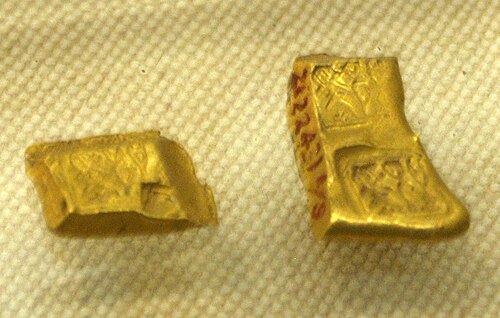
Ying Yuan (Chinese:郢爰;pinyin:yǐng yuán) were stamped blocks of gold bullion. This was an early form ofcurrency that could be considered a precursor togold coins.[1][self-published source] They were issued by the ancient Chinesestate of Chu during theWarring States period between the 400s and late 200s BCE.[1]
Because these gold blocks are inscribed withChinese characters they are variously known asyin zi jin (Chinese:印子金; pinyin:yìn zǐ jīn),jin ban (Chinese:金版; pinyin:jīn bǎn), orgui bi (traditional Chinese:龜幣; simplified Chinese:龟币; pinyin:guī bì).[2]
The oldest ones known are from about the 5th or 6th century BCE.[1] They consist of sheets of gold 3-5mm thick, of various sizes, with inscriptions consisting of square or round stamps in which there are one or two characters.[1] They have been unearthed in various locations south of the Yellow River indicating that they were products of the State of Chu.[1] One of the characters in their inscription is often a monetary unit or weight which is normally read asyuan (Chinese:爰; pinyin:yuán).[1] Pieces are of a very variable size and thickness, and the stamps appear to be a device to validate the whole block, rather than a guide to enable it to be broken up into unit pieces.[1]
Someying yuan contain theChinese characters ying yuan (郢爰).[2]
Another inscription that is sometimes found on these ancient gold blocks ischen yuan (陳爰).[2]
Some specimens have been reported in copper, lead, or clay.[1] It is probable that these werefuneral money, not circulating currency, as they are found in tombs, but the gold ones are not.[1]
 | This coin-related article is astub. You can help Wikipedia byexpanding it. |